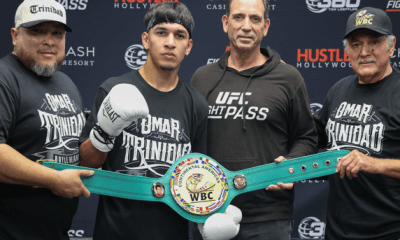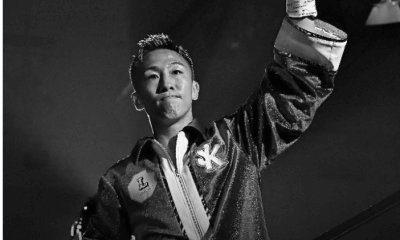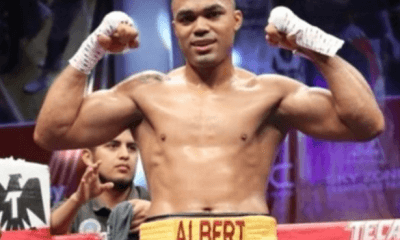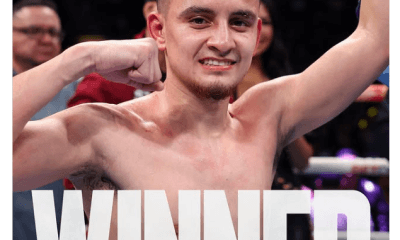Featured Articles
The Hauser Report: Jarrell Miller, PEDs, and Boxing
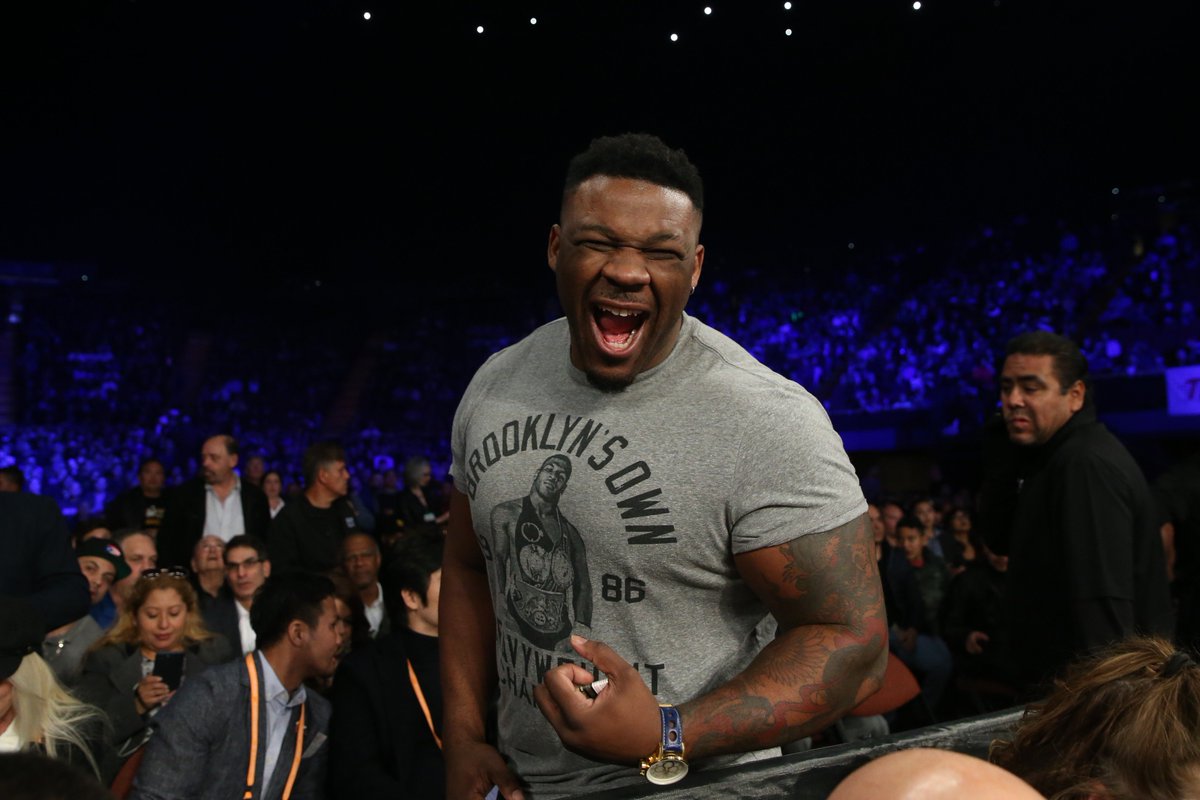
Jarrell Miller is the poster boy this week for the use of banned performance enhancing drugs in boxing. But there’s plenty of blame to go around and people who are more culpable than Miller.
Let’s start with some facts.
Miller was suspended by the California State Athletic Commission in 2014 after testing positive for methylhexaneamine following a Glory 17 kickboxing event. More recently, he was dropped from the World Boxing Council rankings because he refused to join the WBC Clean Boxing Program. When it was time to sign up for PED testing by the Voluntary Anti-Doping Association (VADA) as required by his contract to fight Anthony Joshua at Madison Square Garden on June 1, Jarrell dragged his heels before submitting the necessary paperwork. Meanwhile, at press conferences in New York and London to promote the bout, he accused Joshua of using illegal performance enhancing drugs.
On April 16, it was revealed that a urine sample taken from Miller by a VADA collection officer on March 20 had tested positive for GW1516 (a banned substance also known as Cardarine and Endurobol). GW1516 was developed in the 1990s to treat diabetes, obesity, and cardiovascular disease. Its use was largely discontinued in 2007 after it was linked to the development of cancer during trials on mice. It’s not classified as an anabolic steroid but is considered an anabolic compound and has anabolic properties because it helps build muscle mass. Essentially, it forces skeletal muscle to use fat rather than carbohydrates as an energy source and is also an endurance aid.
On April 17, the New York State Athletic Commission denied Miller’s request for a license that would have allowed him to fight Joshua. In so doing, the commission indicated that, if the B-sample taken from Jarrell on March 20 were tested and came back negative, he could reapply for the license.
That same day, Team Miller formally requested that Jarrell’s B-sample be tested, and Miller posted a statement on social media that read, “I am absolutely devastated upon hearing the news my boxing license has been revoked in NY State and I will be vigorously appealing this decision. I have NEVER knowingly taken any banned substance and, when I found out the news, I was totally shocked. My team and I stand for integrity, decency & honesty and together we will stand to fight this with everything we have! This was a voluntarily test that I was very happy to do and these results came just one week after another voluntarily test that I had taken which was completely clean. I refuse to just lie down and let my dream be taken away from me when I know in my heart that I’ve done nothing wrong. 15 years of hard work. I’m WARRIOR. I don’t need a banned substance.”
One day later, on April 18, VADA notified the New York State Athletic Commission, promoter Eddie Hearn, and both the Joshua and Miller camps that a blood sample taken from Jarrell on March 31 had tested positive for human growth hormone, another banned substance.
On April 19, Miller hit the trifecta when it was announced that a urine sample taken from him by VADA on March 31 had come back positive for EPO (erythropoietin), a banned performance enhancing drug that stimulates the production of red blood cells.
That evening, Miller posted a video on social media in which he acknowledged, “This is your boy, ‘Big Baby’ Miller here, A lot can be said right now. I’ma get straight to the point, I messed up. I messed up. I made a bad call. A lot of ways to handle a situation. I handled it wrongly. And I’m paying the price for it. Missed out on a big opportunity and I’m hurtin’ on the inside. My heart is bleeding right now. I hurt my family, my friends, my team, my supporters. But I’m gonna own up to it. I’m gonna deal with it, I’ma correct it and I’m gonna come back better. I’m humbled by the experience, I understand how to handle certain things. I’m gonna leave it at that. I love you guys and I appreciate you guys out there, and as fighters we go through a lot, I don’t wanna make it a bad name for ourselves. It’s time to do right and get right. So I thank you guys.”
Miller got caught, but he wasn’t alone in his wrongdoing. Forty years ago, Ken Norton was known for his chiseled physique. In boxing’s current PED era, most elite fighters are more chiseled than Norton ever was. They aren’t all clean.
It’s a matter of record that numerous fighters have had “adverse findings” with regard to the use of performance enhancing drugs. The list includes – but is not limited to – Luis Ortiz, Alexander Povetkin, Antonio Tarver, Lamont Peterson, Andre Berto, James Toney, Shannon Briggs, Tyson Fury, Ricardo Mayorga, Lucas Browne, Fernando Vargas, Frans Botha, J’Leon Love, Orlando Salido, Brandon Rios, and Canelo Alvarez. In addition, suspicions have been raised with regard to stars like Floyd Mayweather, Manny Pacquiao, Shane Mosley, and Evander Holyfield.
The United States Anti-Doping Agency began testing professional boxers for performance enhancing drugs in 2010. USADA could have been instrumental in cracking down on the use of PEDs in boxing. Instead, it became an instrument of accommodation. USADA’s website states that it administered 1,501 tests on 128 professional boxers. Yet it reported only one adverse finding regarding a professional boxer to a governing state athletic commission.
By way of comparison, Dr Margaret Goodman (president of the Voluntary Anti-Doping Association) says that close to four percent of the tests for illegal performance enhancing drugs conducted by VADA come back positive. Using the four-percent benchmark, one would expect that 60 of the 1,501 tests conducted by USADA would have yielded a positive result.
In recent months, USADA has conceded to multiple third parties that there was more than one positive test result with regard to a professional boxer but that it chose to “adjudicate these matters internally” without reporting the positive result to the opposing fighter’s camp or state athletic commission that had oversight responsibility with regard to a given fight.
Moreover, it appears as though USADA – with public scrutiny focusing on its test results – has stopped testing professional boxers for PEDs. According to the USADA website (updated through April 20, 2019), the most recent tests conducted on professional boxers by USADA were administered to Danny Garcia and Shawn Porter, who fought each other at Barclay’s Center on September 8, 2018.
In other words, a company that conducted more than fifteen hundred tests on professional boxers over the course of eight years (and reaped hundreds of thousands, if not millions, of dollars from the procedure) suddenly stopped testing professional boxers.
Good riddance.
The various state athletic commissions have also been delinquent in their oversight responsibilities as they relate to illegal performance enhancing drugs. Not one commission has developed the expertise, committed the financial resources, and otherwise demonstrated the resolve to eliminate the use of illegal PEDs.
Four of Miller’s most recent six fights have been under the jurisdiction of the New York State Athletic Commission. One can speculate that Jarrell didn’t suddenly decide to load up on a cornucopia of banned performance enhancing drugs for his fight against Anthony Joshua without having tried any of them before. Hypothetically speaking, he could have been using the same banned substances prior to all of his recent fights.
VADA president Dr. Margaret Goodman says that, had Miller’s samples been collected by the New York State Athletic Commission and tested pursuant to current NYSAC protocols, none of the three banned substances would have been detected. It’s unlikely that the three drugs would have been detected pursuant to the PED testing protocols of any other state athletic commission either unless the tests were administered by VADA.
Does the attention focused recently on Jarrell Miller represent an opportunity to change the culture of PED use in boxing? And if so, how can the culture be changed?
No one entity can rid boxing of performance enhancing drugs. But a coordinated effort by the powers that be can take significant steps in the right direction.
First, a shout out to Margaret Goodman and VADA. Dr. Goodman has waged a courageous, often lonely struggle against the spread of performance enhancing drugs in boxing. She has put an enormous amount of time and quite a bit of her own money into the cause.
Each state athletic commission should demand that a fighter submit to VADA testing as a prerequisite to that fighter being licensed within its jurisdiction. The Association of Boxing Commissions should encourage its members to adopt this policy. If the various state athletic commissions act in concert, it will preclude forum shopping by PED users.
State athletic commissions should also, where appropriate, enlist the aid of law enforcement authorities.
Government entities don’t effectively combat heroin use by prosecuting addicts. In addition to providing treatment for addiction, they combat heroin use by prosecuting the drug traffickers.
There are gyms in the United States that are known as distribution centers for illegal performance enhancing drugs. There are physical conditioners who have a known affinity for these substances. Fighters who have tested positive for illegal PEDs should be asked under oath, “Where did the drugs come from? Who, what, how, when, and where?” We already know why.
The New York State Athletic Commission might try to wash its hands of Miller. The commission might say, “We denied Jarrell a license. He’s not a licensee. Therefore, we have no further jurisdiction over him.”
That would be consistent with the NYSAC looking the other way when Jermall and Jermell Charlo “missed” drug tests prior to fighting at Barclays Center last December.
The NYSAC might also feel that it doesn’t have counsel capable of properly handling the matter. Ryan Sakacs (who previously served as counsel to the commission) once served as a criminal prosecutor and has expertise in drug cases. The current commission counsel seems less suited to the task. But the NYSAC could reach beyond its immediate staff to find more experienced counsel in the New York State Department of State or Attorney General’s Office. The NYSAC could also reach out to Sakacs and retain his services on an hourly basis (which was his arrangement with the commission prior to his departure).
Promoters should encourage VADA testing to protect their clean fighters. In that regard, a special message is in order for Premier Boxing Champions and Al Haymon. They haven’t done the majority of their fighters any favors by steering them clear of meaningful VADA testing. What they have done is ensure that many PBC fighters are getting hit in the head harder than would otherwise be the case.
The television networks and streaming video channels that now provide the bulk of the money for boxing should require VADA testing for every fighter who appears in a main event or co-featured bout on their network.
The world sanctioning organizations should follow the lead of the World Boxing Council and institute drug-testing programs similar to the WBC Clean Boxing Program.
The media has to be more vigilant and more involved in exposing the use of illegal performance enhancing drugs in boxing.
And most important, fighters should demand VADA testing. They’re the ones who are most at risk.
Right now, many elite fighters feel that they have to use performance enhancing drugs to be competitive against other fighters who are juicing. But as years pass, this escalation of weaponry will take a hideous toll on them.
Credible PED testing is expensive. It’s impractical to think that it can be put in place for every fighter and every fight. But spot testing is a partial deterrent. Some of the hundreds of millions of dollars being poured into boxing now by DAZN, ESPN, and Fox should be used to fund VADA PED-testing programs.
Talking about performance enhancing drugs several months ago, Jarrell Miller said, “Your life is on the line. Your career is at stake. Guys are gonna do what they gotta do.”
So a thought in closing.
The Bible tells us that Jesus told those who would stone an adulteress, “He that is without sin among you, let him first cast a stone (John, Chapter 8, Verse 7).
Let’s adapt that thought for today’s fighters: “He that is without sin among you, let him sign up for VADA testing.”
Thomas Hauser’s email address is thomashauserwriter@gmail.com. His most recent book – Protect Yourself at All Times – was published by the University of Arkansas Press. In 2004, the Boxing Writers Association of America honored Hauser with the Nat Fleischer Award for career excellence in boxing journalism.
Check out more boxing news on video at The Boxing Channel
To comment on this story in The Fight Forum CLICK HERE
-

 Featured Articles3 weeks ago
Featured Articles3 weeks agoThe Hauser Report: Zayas-Garcia, Pacquiao, Usyk, and the NYSAC
-

 Featured Articles2 weeks ago
Featured Articles2 weeks agoOscar Duarte and Regis Prograis Prevail on an Action-Packed Fight Card in Chicago
-

 Featured Articles1 week ago
Featured Articles1 week agoThe Hauser Report: Cinematic and Literary Notes
-

 Book Review4 days ago
Book Review4 days agoMark Kriegel’s New Book About Mike Tyson is a Must-Read
-

 Featured Articles4 weeks ago
Featured Articles4 weeks agoManny Pacquiao and Mario Barrios Fight to a Draw; Fundora stops Tim Tszyu
-

 Featured Articles4 weeks ago
Featured Articles4 weeks agoArne’s Almanac: Pacquiao-Barrios Redux
-

 Featured Articles3 weeks ago
Featured Articles3 weeks agoRemembering Dwight Muhammad Qawi (1953-2025) and his Triumphant Return to Prison
-
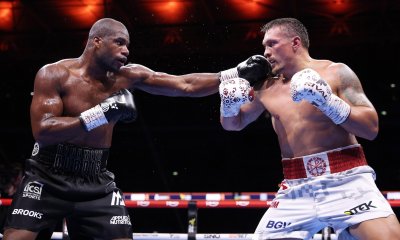
 Featured Articles4 weeks ago
Featured Articles4 weeks agoOleksandr Usyk Continues to Amaze; KOs Daniel Dubois in 5 One-Sided Rounds


